A Mobster Montage
(With Examples)

Mobster Montage
Caricatures are, as everyone knows, drawings of individuals where certain features have been exaggerated. How much and what the artist exaggerates is a matter of personal choice.
Caricatures which have relatively little exaggeration are sometimes called portricatures. An example of this artistic genre is the drawing of pioneering radio broadcaster, Lowell Thomas.

Lowell Thomas
Portricature
Portricatures are what you often see sold by sidewalk caricaturists. That's because with relatively little exaggeration, the drawings are not likely to cause offense, something an artist doesn't want to happen with a paying client.
As far as - quote - "classic caricatures" - unquote - go, the best subjects are those that have one or two distinguishing figures which are suitable for exaggeration. Contrary to popular belief, exaggeration can be shrinking a feature and strong exaggerations may even enhance the likeness - or at least the recognizably - of the subject. The caricature of President Franklin Delano Roosevelt we see here is an example of a classic caricature.
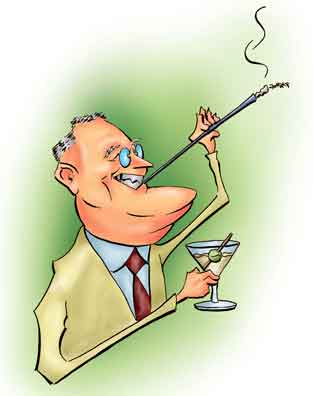
FDR
Classic Caricature
Another style of rendering is more cartoonish and are simple in design with even stronger exaggerations than classic caricature as we see in this drawing of actress Nicole Kidman (a drawing which actually received an accolade from a CooperToons viewer).
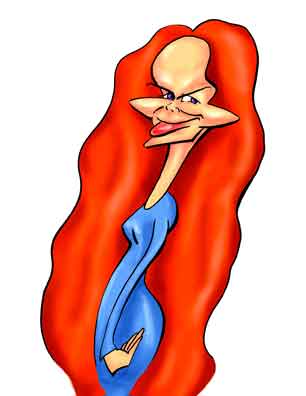
Nicole Kidman
Such renderings were particularly popular in animated features from the 1940's through the 1960's. Animated short subjects lasting about seven minutes were typically shown before the feature film (now you get commercials). In some of the more satirical cartoons, the main characters might appear alongside cartoon versions of big-name stars like Peter Lorre, Edward G. Robinson, Humphrey Bogart, and Lauren Bacall.
As an example of this type of - quote - "artwork" - unquote - is the Montage of Merry Mobsters shown at the top. From left to right we have Carlo "Don Carlo" Gambino, Paul "Big Paul" Castellano, Joseph "Crazy Joey" Gallo (top), Frank "The Prime Minister" Costello (bottom), and Carlos "Little Man" Marcello.
One notable characteristic of American mobsters which helps with their caricaturability is their nicknames. The actual nicking comes from various sources, friends, family, foes, and (of course) the news media. For some monikers the choice is obvious: "Fat Tony" Salerno, "Big Jim" Colosimo. Some mobsters are labeled by their reputed mode of operation, habits, or personality: Anthony Joseph "Joe Batters" Accardo, Carmine "Cigar" Galante, Joseph "Joey the Clown" Lombardo, Jimmy "The Fox" Torino. Other names are not necessarily welcome by the mobsters themselves: Benjamin "Bugsy" Siegel, Jimmy "The Weasel" Fratianno, and Vincent "The Chin" Gigante.
Carlo "Don Carlo" Gambino was a man who, as they say, always enjoyed ill-health. Or at least he could use his infirmities to his advantage. Whenever it seemed the authorities got close to bringing him to trial, deportation, or any other inconvenience, his frailty would conveniently assert itself.
Carlo was born in Palermo, Sicily in 1902. His parents are somewhat shadowy figures and about all we know of his ancestry is "Gambino" was his mom's maiden name.

Carlo Gambino
Enjoying Ill-Health
Carlo was 19 when on December 23, 1921, he arrived in the United States as a stowaway on the SS Vincenzo Florio. Stowaway is a bit of a misnomer. He had been given free passage and skipped those pesky formalities like passports and other required documentation. The captain of the ship was, of course, compensated for his efforts.
This was pretty much standard operating procedures for the Mafia in Sicily which had been sending their younger and more promising members to the Land of the Free and the Home of the Buck. The ship docked in Norfolk, Virginia where arrangements had been made to take Carlo to New York. There he got a job working in a garage for his cousin, Paul Castellano. He also married Paul's sister (i. e., his first cousin).
When Carlo arrived in America, prohibition was in full swing. So to pick up additional cash, Carlo began selling bootlegged liquor. He not only made moonshine as a basement business but he also would take small boats off Long Island and pick up shipments coming up from Cuba and other countries where making booze was legal. Another of his jobs was to "persuade" speakeasy owners that it was best for them to buy their hooch from the New York mobster, Guiseppe "Joe the Boss" Masseria.
But Guiseppe was not the only mob boss in town. You also had Salvatore "Little Caesar" Maranzano. Salvatore felt that Guiseppe had too much of the booze business and so began hijacking Guiseppe's trucks. Guiseppe responded by demanding payoffs from Salvatore and soon there was a real set-to. Being no fool, young Carlo had begun to work for Salvatore while nominally remaining on the payroll of Guiseppe.
Because Salvatore was from Castellammare del Golfo in Sicily, the fracas between him and Guiseppe was called the Castellammarese War. The war ended fairly abruptly on April 15, 1931 when some men came into the restaurant where Guiseppe was having lunch and shot him in the back. Despite what you read or see on "what-really-happened" television shows, who was with Joe and who dispatched him is lost to history.
It's Salvatore who is generally credited with setting up the "Commission" for the "Five Families". The Commission is now legendary and was the group of the New York mob bosses who would meet from time to time.
Salvatore called himself càpo di tùtti I càpi. That is, The Head of All the Heads. Or as we prefer, The Boss of All the Bosses. And when the Commission met, if Salvatore said to do it, they were expected to do it.
But there were these young whippersnappers! They thought everyone regardless of race, creed, or national origin should work together. This was America and they didn't think there should be a Boss of All Bosses stuff. One of the advocates of the democratization of organized crime was Charles "Lucky" Luciano.
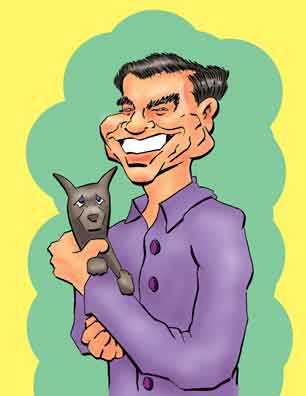
Charles Luciano
They didn't need no bosses.
Salvatore decided he had to get rid of Charles. According to a widely accepted account, Salvatore asked Vincent "Mad Dog" Coll to stop by. Vincent, for those who have to have it spelled out, had a reputation for handling troublemakers.
But while waiting in his office for Vincent to show up, Salvatore was told that a group of tax agents wanted to see him. OK, said Salvatore, send them in.
Although from an epistemological standpoint, we don't know who was in the group of men, many people think it was a bunch hired by Charles. But what is not speculation is that Salvatore was stabbed multiple times and then shot for good measure.
Salvatore had set Charles up with his own crime family (commonsensically called the Luciano Family). But he, Salvatore, as The Boss of All Bosses, was the head of the Commission. But Charles now said, yes, there was still the Commission, but with a difference. There was to be no Boss of All Bosses. The Commission was now a group of bosses who would meet to resolve any disputes peaceably.
And Carlo? Well, he was able to remain in the background throughout the Castellammarese War, and with all the reorganizations, he was now a member of the Mangano Family run by Vincente "The Executioner" Mangano. At this time Carlo was still just a caporegime which is kind of a middle level manager who ran a group - called a borgàta. Carlo also stuck pretty much with working within the one crime family and didn't try to muscle in on any one else's territory.
Carlo still made a lot of money. After Prohibition ended in 1933 and unlike many former bootleggers, he kept making illegal booze and selling it at a discount. Then when World War II came along, a good chunk of his income came from selling stolen ration stamps. He had also risen up high enough in the mob hierarchy that he was now getting dough from mob controlled businesses.
One of the most lucrative of these enterprises was making arrangements with the industries that were located on the New York City waterfront. The trick here was you didn't have to actually own shares in the companies. You just convinced the men who handled the shipping to give you a weekly donation. If you didn't get your payment, then it seems the shipments didn't get loaded or unloaded. And you could also simply hijack the cargo and sell it off yourself.
The men who did the actual work also contributed a percentage of their wages. Of course, they also had to pay their union dues, a portion of which were deducted by the mob. Naturally with this system the dock workers often ended up being short of cash and the mobsters would happily grant them loans at exorbitant interest rates.
Carlo had a hand in almost all these enterprises, and had also used the money to buy more or less legitimate companies. These included food producers, meat markets, construction firms, dress factories, and pizza parlors just to name a few. By the end of the 1940's, Carlo was one of the most well to do of the Mangano underbosses.
Now moving up in the mob usually was based on seniority. When the capo - quote - "retired" - unquote - everyone slid up a notch. By April, 1951, the #2 man in the Mangano organization was Albert "The Mad Hatter" Anastasia. But Albert felt that Vincent was getting old and should move on. He must have gotten his wish since no one ever heard from Vincent again.
Now Albert was in charge. But before long the others in the family were finding fault, although we don't know precisely who was finding fault or what the faults were. But it sufficed. On October 25, 1957, as Albert was sitting in a barber's chair in downtown Manhattan, two masked men walked in and opened fire. Albert was hit four times and died almost immediately.
And who were those masked men? No one really knows.
Carlo was now in charge, and the family was now called the Gambino Crime Family. This is the name by which we call it today.
It's sometimes forgotten that Carlo was a contemporary of many of the iconic mobsters of the early 20th century. Born in 1902, Carlo was of an age with Alphonse "Scarface" Capone (1899), Charles Luciano (1897), John Dillinger (1903), and Charles Arthur "Pretty Boy" Floyd (1904). Nevertheless, Carlo remained virtually unknown to the general public until the mid-1960's. But it wasn't until 1970, when Carlo was arrested by the FBI that people began seeing him on television.
Carlo never went to trial as his convenient ill-health seemed to kick in whenever he was supposed to appear. And when he was paraded before the television cameras, he never answered reporter's questions and always had his trademark (and rather creepy) smile on his face. He was probably smiling when he died - in his own bed - October 15, 1976.
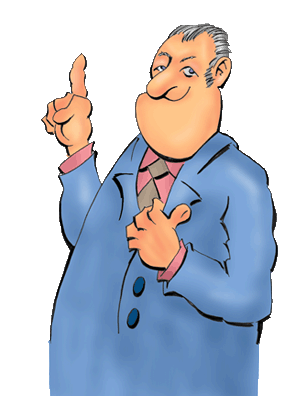
Paul Castellano
Breaking the Mold
With Carlo gone, his cousin "Big Paul" Castellano was now in charge. But Paul wasn't from the old mold of mob bosses. He kept his distance from the guys on the street and seemed aloof and standoffish. He also had a temper and a difficult personality. The lower echelons also saw him as increasingly tightfisted. In anticipating the modern American executive, Paul began demanding big bonuses when he actually contributed little or nothing to actually getting the money in.
Worse and worse, Paul didn't live in a modest row house in the old neighborhoods where he could rub elbows with the hoi polloi. Instead he moved to a sprawling mansion on Staten Island called the "White House". Now when his fellow mobsters had to fork over their ill-gotten moolah to Paul, they had to make appointments or they couldn't get by the tall walls and iron gates.
Paul had married fairly young and to a lady he had known for years. But once he and Mrs. Castellano were esconded in their Staten Island mansion, he became enamored of their live-in maid. Mrs. Castellano was less enthusiastic of Paul's employee relations and soon moved out.
Like many besmitten men, Paul thought that whatever his young lady friend did was fine with him. When she was doing her shopping, FBI men began inviting her to sit down for a cup of coffee. She told Paul about the meetings, but he said don't worry. Just answer their questions and don't lie.
Not surprisingly Paul preferred to stay home and when not involved in his amorous activities would watch television from the then popular satellite dishes. But then the set began to go on the fritz.
The television troubles had, in fact, been caused by the FBI interfering with the satellite beams. This wasn't just the FBI giving Paul a hard time. It seems that when Paul's girlfriend had sat down for a friendly cup with one of their agents, she had innocently mentioned how her boss would sit at the kitchen table and talk with the various visitors who dropped by now and again. She had also had mentioned that the connections to the satellite dish went through a cabinet in the kitchen.
Of course when the repair man showed up he was an FBI electronics expert who promptly and on the pretext of fixing the TV surreptitiously planted a bug in Paul's kitchen. Soon the FBI began arresting and securing convictions of mob members who were meeting with Paul. The word was out that it was Paul's lack of vigilance that was causing all the problems.
Still, Paul managed to hang on for quite a while. Then on December 16, 1985, as he was getting out of his car at Sparks Steak House in Manhattan, two men ran up and blasted both Paul and his driver.

Frank Costello
The PM
When Charles Luciano had taken charge of the operations from Salvatore, his #2 man - the consigliere - was Vito "Don Vitone" Genovese. But Vito had been implicated in a number of murders, and soon (and voluntarily) he left the United States to spend some years in Italy. He finally returned to New York after World War II, but was never able to regain the top spot. Instead Frank Costello was in charge.
The 1950's also saw the first of the Congressional hearings on organized crime headed by senators like John McClellan and Estes Kefauver. When Frank - called "The Prime Minister" - was now summoned to appear, television audiences got a chance to see the most powerful mob boss himself.
Of course, for a lot of the questions Frank took the Fifth Amendment and eventually got so tired of the questions - which he thought were disrespectful - that he finally walked out of the session. This got him slapped with a contempt of Congress citation, and he spent over a year in jail.
Except for his stint for contempt, Frank remained free. In 1973, as Carlo had been able to do, Frank managed to die in his own bed.
One of the strangest episodes in the annals of organized crime was the Adventures of Carlos Marcello. Carlos, lived and worked in New Orleans.
In the 1960's, hearings on organized crime were continuing, largely due to the efforts of the attorney general, Bobby Kennedy. Called to testify, Carlos repeatedly refused to answer because he said his answers may "intend" to incriminate him. He also used a lot of double negatives and would say things like "I am not in no racket" and "I am not in no organized crime" - which to a logician sounds like a confession. Carlos soon became the #1 member of the Anti-Bobby Fan Club.

Carlos Marcello
A Strange Story
The feeling was mutual, and Bobby had an idea on how to deal with Carlos. You see, Carlos was most likely born in Tunisia in 1910 and his Sicilian parents soon immigrated to America. Evidently they never became US Citizens and so neither was Carlos. But because when he was young Carlos had been arrested, he would always be subject to deportation.
As a resident alien, Carlos had to report to an officer of the immigration services. To his surprise on April 4, 1961, at one of these routine meetings and amidst his voluble protests, Carlos was said he would be immediately deported.
And to what country? It was - get this - Guatemala.
You see, some time earlier Carlos had a great idea - at least it seemed so at the time. He had given the government - quote - "documentation" - unquote - that he was born in Guatemala. Well, if Carlos said he was from Guatemala, to Guatemala Carlos would go.
And when we said Carlos would be deported immediately we mean immediately. Without any hearing or being allowed to talk to family, friends, or a lawyer, Carlos was handcuffed, put on a plane, and dumped rather unceremoniously in Guatemala City.
Now we have to admit that the government's action was most irregular. And Guatemala didn't want Carlos, either. Once in the country, he was immediately slated for deportation again. But the Guatemalan officials knew America wouldn't take Carlos back. So what to do?
Well, that was easy. The police simply drove Carlos to the border with El Salvador and dropped him off. There in the middle of the jungle and at the high altitude and sweltering heat, Carlos walked over fifteen miles to the nearest village. But this wasn't in El Salvador. It was across yet one more border, in Honduras.
Still wearing his high priced but now rumpled and no doubt rather ripe business suit, Carlos was put up for a few days at an army post. Then the soldiers, wishing their guest ¡Vaya, con Dios!, put him on a bus and sent him on to the capital city, Tegucigalpa (always a good trivia question). Then via his connections - he was a mob boss, after all - Carlos managed to get on a private plane and in secret was flown back to New Orleans.
Back in the Good Old USA, Carlos was able to successfully fight further deportation. But it wasn't smooth sailing and eventually in 1982 the Feds nabbed him for corruption and labor racketeering. That sent Carlos to jail for six and a half years. He was released, old and ailing, after a reversal of his conviction. Carlo lived over a decade longer and died in 1993.

Joe Gallo
The Hip Mobster
One of the most unusual of the famous mobsters was Joseph "Crazy Joey" Gallo. Joseph followed the lead of Charles Luciano in seeing himself as primarily an American. He was also of the new counterculture generation that saw the rise of the Beatniks (he was seven years younger than Jack Kerouac).
Joseph started out as a low level member of the Profaci Crime Family. But Joseph was becoming dissatisfied with the slow rate of promotion. So he split off on his own and he and his friends began kidnapping other gang members and holding them for ransom. Naturally this irritated a lot of people, and in 1961 two men attempted to kill Joseph's brother, Larry, in a bar during an episode which apparently served as the model for one of the scenes in Mario Puzo's The Godfather. A few months later Joseph was sentenced to 14 years in prison for a number of mob related crimes.
In prison Joseph made friends. These were of all races and included African American inmates. Joseph was also a model prisoner and began to read the classics including the writings of Jean-Paul Sartre. Then during a prison riot Joseph helped save the life of a guard. This act was certainly in his favor when his parole hearing came up. He was released in 1971.
Back in New York, Joseph began to hang out with the cool people and he even moved to Greenwich Village. He became quite chummy with celebrities and entertainers which included the comedian David Steinberg who was the best man at Joey's wedding.
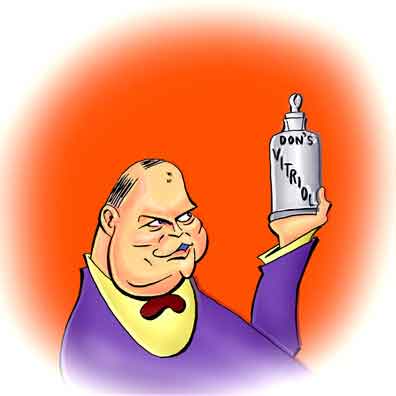
Don Rickles
He declined the invitation.
On his 43rd birthday, Joseph, some friends, and his bride of three weeks and her young daughter, had attended a performance of comedian Don Rickles at the Copacabana nightclub. After the show and in the wee hours of the morning everyone was out looking for a restaurant that was still open (supposedly Joseph invited Don to join them but Don declined). Most places were closed but as the entourage drove by Umberto's Clam House they saw it was still open. After being assured by some bystanders the food was good, Joseph and everyone went in.
The usual story is that as Joey was starting on his second helping, two men walked in, pulled out guns, and started to shoot. Joseph upended a table to protect his wife and step-daughter, but he was hit twice. His bodyguard, who returned the fire, was also wounded but not seriously. Joseph staggered out the door and collapsed in the street. He was taken to a hospital where he was pronounced dead.
As we said, the usual story is that there were two killers. However, a newspaper report written that day stated that there was only one gunman. The latter account was usually discounted. However, this "lone gunman theory" has had a recent shot in the arm. But that, as they say, is another story.
References
The Mad Art of Caricature, Tom Richmond, Deadline Demon Publishing, 2011.
Mafia Dynasty: The Rise and Fall of the Gambino Crime Family, John Davis, HarperCollins, 1993.
"Gangster Nicknames", Thomas Hunt, The American Mafia
Little Man, Robert Lacey, Little Brown, 1991.
"Harold Conrad, 80, Promoter and Writer", The New York Times, May 20, 1991.
"He Turned Gossip Into Tawdry Power; Walter Winchell, Who Climbed High and Fell Far, Still Scintillates", The New York Times, November 18, 1998.
Those Great Old-Time Radio Years, Aubrey J. Sher, XLibris, 2013.
"Where Do Mob Nicknames Come From?", Daniel Engber, Salon, May 9, 2005.
"Mafia Boss Carlo Gambino Is Bagged for Robbery Plot", Edward Kirkman and Harry Schlegel , New York Daily News, March 24, 1970, (Reprinted: March 22, 2015)
Gangsters, Swindlers, Killers, and Thieves: The Lives and Crimes of Fifty American Villains, Lawrence Block, Oxford University Press, USA, 2004.
"Crazy Joe is Killed at a Little Italy Restaurant", Frank Faso and Edward Kirkman, New York Daily News, (Reprinted: April 8, 1972).
Mafia Dynasty: The Rise and Fall of the Gambino Crime Family, John Davis, HarperCollins, 1993.
"The Gambinos: The First Family of Crime", Biography, A&E, 1997.
Mobsters, The Biography Channel, 2007 - 2017. Note, there is some confusion - even on "informational" websites - with two series of the same name. One was a dramatization of the lives of various mobsters full of invented dialog and fictionalized scenes. The other - which is the one cited here - was a typical "talking heads" series, which, although there was some recreations of events - is more or less straight documentary.
The following episodes are useful for anyone wanting a quick overview of the Merry Mobsters discussed herein.
"Paul Castellano", July 12, 2008, Internet Movie Data Base.
"Lucky Luciano", May 29, 2007, Internet Movie Data Base.
"Frank Costello", May 8, 2007, Internet Movie Data Base.
"Carlos Marcello", July 26, 2008, Internet Movie Data Base.
"Joey Gallo", December 4, 2009, Internet Movie Data Base.
"The Mob's Greatest Hits, January 15, 2010, Internet Movie Data Base.